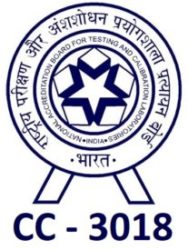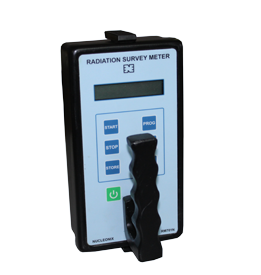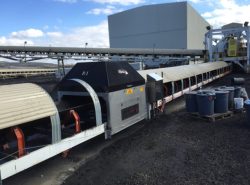Introduction to Radiation Monitors for Industry
Technical Data

Introduction & Applications of Radiation Monitors in Industry
Radiation Monitors are widely in use by the Industry, for various applications, (Primarily to monitor radiation levels from safety angle) which may include Irradiation plants, Nucleonic level gauges, cross belt analysers using PGNAA technique, Industrial radiograph, Neutron & Gamma well logging by oil & gas Industry, Gamma Irradiation chambers / Blood irradiator, Beta thickness gauges, coal Ash measuring devices etc.
For all these case Nucleonix can offer Radiation Protection instruments which are required from the angle of Radiation Safety & are mandatory as per regulator (AERB). These Radiation Monitors include Gamma Radiation Survey Meter, Contamination Monitor, Area Gamma Monitors, Neutron Survey Meters & Area Monitors etc.
1) Irradiation Plants:
Nucleonix, can offer complete Radiation monitoring instrumentation for Food/Medical Products-Irradiation plants- These products include Radiation survey meters, Area gamma monitors- low & High range, networking software to connect all AGMs for centralized monitoring, TL research reader -to measure dose delivered to consignments in packed cartoons.
Food Products irradiation is the process of exposing food and food packaging to ionizing radiation. Ionizing radiation, such as from gamma rays, x-rays, or electron beams, is energy that can be transmitted without direct contact to the source of the energy (radiation) capable of freeing electrons from their atomic bonds (ionization) in the targeted food.[1][2] The radiation can be emitted by a radioactive substance or generated electrically. This treatment is used to improve food safety by extending product shelf-life (preservation), reducing the risk of foodborne illness, delaying or eliminating sprouting or ripening, by sterilization of foods, and as a means of controlling insects and invasive pests.[3] Food irradiation primarily extends the shelf-life of irradiated foods by effectively destroying organisms responsible for spoilage and foodborne illness and inhibiting sprouting. Similarly Medical products also could be sterilized in packed cartoons
Medical products irradiation: Radiation sterilization using gamma radiation is a well established industrial process in India. It is a very efficient and convenient technique for achieving a high level of sterility in medical supplies. Hermetically sealed medical products in cardboard cartons or aluminum tote boxes are generally exposed to a minimum dose of 25 kiloGray. Exposure of medical products, manufactured under Good manufacturing Practices (GMP), to minimum radiation dose of 25 kGy ensures sterility assurance level (SAL) of the order of 10-6 . This dose provides an extremely high safety factor, and when the product has low initial microbial count.
List of the Products covered under Drugs and Cosmetic Act Rules, 1945 and are cleared by Food and Drug Administration, Maharashtra for routine sterilization for use in the country and for export purposes is as follows:
Absorbent Cotton Wool and Absorbent Gauze Products
1. Bandages – Crape, cotton crape, gauze.
2. Cotton – buds, pads, swabs.
3. Dressings – finger dressings, first field dressings, paraffin gauze dressings, shell dressings Kits – Maternity/Dai, Minor Surgery, Vasectomy.
4. Sutures: with or without needles (Absorbable/Non-absorbable) – catgut, linen, polyester and silk
5. Hemostat Medical Devices: Absorbable gelatin sponge, Perfusion sets, Hypodermic syringes and needles, Intra-uterine contraceptive devices (IUCD).
6. Pharmaceuticals, Powders and Others: Debrisan, Neomycin sulphate powder, Prickly heat powder (containing boric and salicylic acid), Fluorescein sodium strips, Catalina tablets.
Ophthalmic Ointments in Paraffin Base
1. In Collapsible Aluminum Tubes: Atropine Sulphate, Chloramphenicol, chlortetracycline, Gentamycin sulphate, Neosporin (Neomycin sulphate, polymyxin, and bacitracin), Tetracycline.
2. In Soft Gelatin Capsule: Chloramphenicol.
3. Skin Ointments in Polyethylene Glycol Base: Neomycin sulphate Hydrocortisone acetate, alpha chymotrypsin.
4. Cosmetics: Artificial eyelash, Eyebrow pencil, Face powder, Kajal, Lipstick, Cosmetics : Artificial eyelash, Eyebrow pencil, Face powder, Kajal, Lipstick, Talcum powder.
5. Veterinary Products: Quinupramine chloride and sulphate.
Ayurvedic Products and Raw Materials
1. Special Products (mainly for export) : Belladonna dry extract, Ergot Powder, Papain, Rauwolfia serpentine
2) Use of, cross belt PNGAA analysers- in Cement, Coal, Minerals Processing Plants: Cross belt PNGAA analysers, employ Neutron source, hence it is mandatory to have a Neutron survey meter or Neutron Area monitor as Health & safety instrument as per the Regulator (AERB-in India). ‘Nucleonix systems’, offers both the meters for the above three industries namely coal, cement and Mineral processing industries, using cross belt Analysers.
Cross belt analysers, using PGNNA, detect the presence of and measure the quantity of elements in bulk materials as they are transported on a belt conveyor. Real time, continuous data on the elemental composition of the material is sent from the analysers to the plant PLC where it is used for process control.
Cement, Coal, Minerals : Coal mines must meet a variety of customer specifications for different coal qualities. The Elemental Cross belt Analyzer provides real-time quality analysis of critical process streams to facilitate sorting, blending and out-of-seam dilution control. Multi-gamma (Combination of both Ash and Moisture Analysers), is used for accessing ash content in the coal which is very important to know the quality of coal. It is mandatory to have a Gamma Radiation Survey meter, for this purpose from safety angle & to meet Regulators (AERB) requirement.
Cross Belt PGNAA Analyzer for Minerals: The Cross Belt PGNAA Analyzer for Minerals continuously measures the concentration of individual chemical elements of interest in mineral ores, ore mixes, sinters and concentrates.
wide range of minerals applications include: Monitoring of ROM streams including screening Stockyard QC Management, including sorting and blending. Optimizing at key quality locations in minerals processing plants. Quality control in metals production, for example blast furnace sinter process. Product grading at bulk terminals and ship load outs
3. Radiography:
Radiography is a non-destructive test method that utilizes electromagnetic energy (radiation) from X-rays or gamma rays; it detects both surface and internal discontinuities. Radiographs are two-dimensional negative images (projections) of objects on radiation sensitive films/plates.
Cobalt 60 and Iridium 192 are the more commonly used industrial gamma ray sources. The practical thickness limit for carbon steel gamma radiography is approximately 2.5″ for Iridium 192 and 9″ for Cobalt 60. Se-75 gamma radiography is used to inspect thin wall small diameter butt welds. Se-75 is excellent for congested work sites since much smaller restricted areas are required. Se-75 has a practical thickness limit for steel of approximately 0.75”.
In Radiography inspections as-fabricated pressure vessels and piping welds routinely in fabrication shops and within plants can be carried out. Radiography shadow shots also help in inspecting- process piping, pressure vessels and valves for metal losses. Gamma Radiation survey meter is mandatory for all these Radiographers from radiation safety angle as per regulators guidelines.
4. Oil & gas Well Logging- Neutron logging:
Oil Drilling and Exploration companies for Gamma bore hole logging.
5. Radiation monitors (Gamma) – mandatory as a Health & safety instrument in the following applications- facilities/fields.
1) Gamma Irradiation Chambers/Blood Irradiators
2) IR192, co-60 radiography
3) Nucleonic Gauges
6.Digital Contamination monitors (Beta-Gamma)- mandatory as a Health & safety instrument in the following applications- facilities/fields. Thickness control & measurement: Paper mills, Plastic film and other similar industries where thickness measurement is done using Beta devices/ Gauges.








